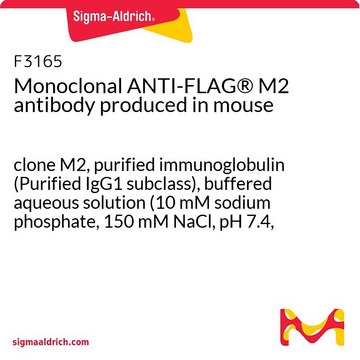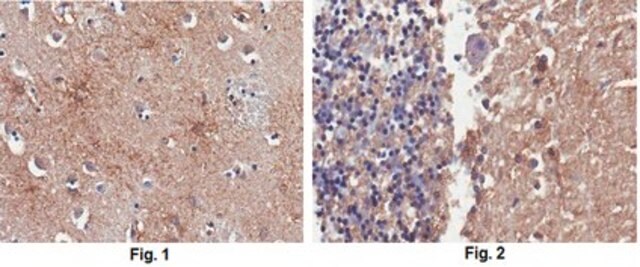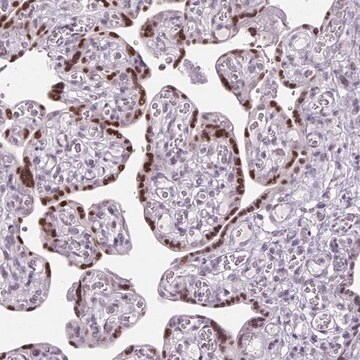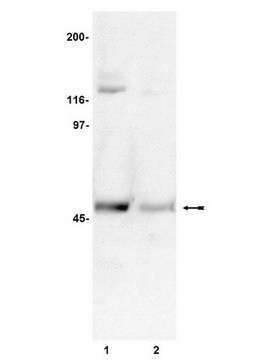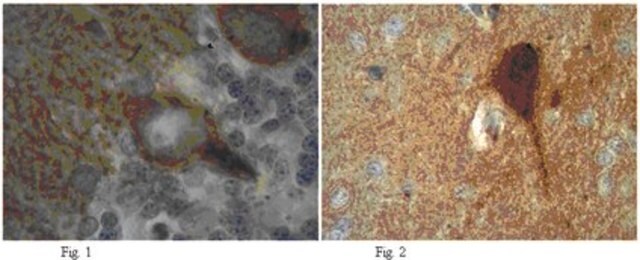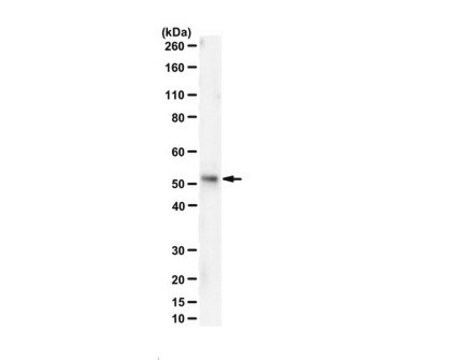AB3637
Anti-DEDAF Antibody
Chemicon®, from rabbit
Synonym(s):
Anti-AAP1, Anti-APAP-1, Anti-DEDAF, Anti-YEAF1
Sign Into View Organizational & Contract Pricing
Select a Size
All Photos(1)
Select a Size
Change View
About This Item
UNSPSC Code:
12352203
eCl@ss:
32160702
NACRES:
NA.41
Recommended Products
biological source
rabbit
Quality Level
antibody form
affinity purified immunoglobulin
antibody product type
primary antibodies
clone
polyclonal
species reactivity
human, rat, mouse
manufacturer/tradename
Chemicon®
technique(s)
western blot: suitable
NCBI accession no.
UniProt accession no.
Specificity
Apoptosis is related to many diseases and induced by a family of cell death receptors and their ligands. Cell death signals are transduced by death domain (DD), death effector domain (DED), and caspase recruitment domain (CARD) containing molecules. DEDAF (DED Associated Factor) is expressed in multiple tissues and cell lines. DEDAF is identical to the transcriptional repressor RYBP. DEDAF interacts with FADD and augments the formation of CD95/FADD/Caspase-8 complexes at the cell membrane. DEDAF also interacts with DEDD (DED-containing DNA binding) protein in the nucleus, which indicates its involvement in the regulation of both cytoplasmic and nuclear events of apoptosis.
Immunogen
Rabbit anti-DEDAF polyclonal antibody was raised against a synthetic peptide corresponding to amino acids 215 to 228 of human-DEDAF. This sequence is identical to the mouse sequence.
Application
Research Category
Apoptosis & Cancer
Apoptosis & Cancer
Research Sub Category
Apoptosis - Additional
Apoptosis - Additional
This Anti-DEDAF Antibody is validated for use in WB for the detection of DEDAF.
Western blot: 0.5-1 μg/mL.
A549 or HepG2 cell lysate can be used as a positive control and a 32 kDa band should be detected.
Optimal working dilutions must be determined by end user.
A549 or HepG2 cell lysate can be used as a positive control and a 32 kDa band should be detected.
Optimal working dilutions must be determined by end user.
Physical form
Format: Purified
Purified IgG by immunoaffinity chromatography. Liquid in PBS containing 0.02% sodium azide.
Storage and Stability
Maintain refrigerated at 2-8°C in undiluted aliquots for up to 12 months.
Legal Information
CHEMICON is a registered trademark of Merck KGaA, Darmstadt, Germany
Disclaimer
Unless otherwise stated in our catalog or other company documentation accompanying the product(s), our products are intended for research use only and are not to be used for any other purpose, which includes but is not limited to, unauthorized commercial uses, in vitro diagnostic uses, ex vivo or in vivo therapeutic uses or any type of consumption or application to humans or animals.
Not finding the right product?
Try our Product Selector Tool.
Storage Class Code
10 - Combustible liquids
WGK
WGK 2
Flash Point(F)
Not applicable
Flash Point(C)
Not applicable
Certificates of Analysis (COA)
Search for Certificates of Analysis (COA) by entering the products Lot/Batch Number. Lot and Batch Numbers can be found on a product’s label following the words ‘Lot’ or ‘Batch’.
Already Own This Product?
Find documentation for the products that you have recently purchased in the Document Library.
Rybp/DEDAF is required for early postimplantation and for central nervous system development.
Pirity, MK; Locker, J; Schreiber-Agus, N
Molecular and cellular biology null
Izabella Bajusz et al.
Genes, 10(11) (2019-11-23)
Separation of germline cells from somatic lineages is one of the earliest decisions of embryogenesis. Genes expressed in germline cells include apoptotic and meiotic factors, which are not transcribed in the soma normally, but a number of testis-specific genes are
Nathan R Rose et al.
eLife, 5 (2016-10-06)
Polycomb group (PcG) proteins function as chromatin-based transcriptional repressors that are essential for normal gene regulation during development. However, how these systems function to achieve transcriptional regulation remains very poorly understood. Here, we discover that the histone H2AK119 E3 ubiquitin
Histone acetylation and the maintenance of chromatin compaction by Polycomb repressive complexes.
Eskeland, R; Freyer, E; Leeb, M; Wutz, A; Bickmore, WA
Cold Spring Harbor Symposia on Quantitative Biology null
E García et al.
The EMBO journal, 18(12), 3404-3418 (1999-06-16)
The products of the Polycomb group (PcG) of genes are necessary for the maintenance of transcriptional repression of a number of important developmental genes, including the homeotic genes. A two-hybrid screen was used to search for putative new members of
Our team of scientists has experience in all areas of research including Life Science, Material Science, Chemical Synthesis, Chromatography, Analytical and many others.
Contact Technical Service
